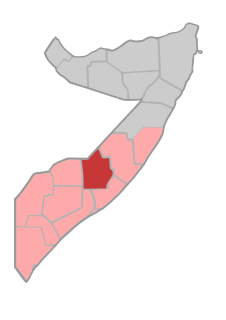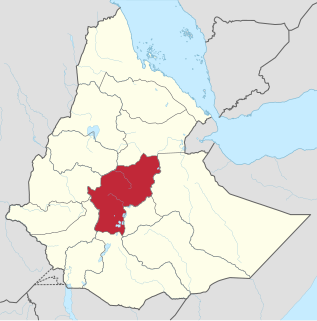See also
Woredas of the Benishangul-Gumuz Region | ||
|---|---|---|
| Asosa Zone | ||
| Kamashi Zone | ||
| Metekel Zone | ||
| Special woredas | ||
This is a list of the 20 woredas, or districts, in the Benishangul-Gumuz Region of Ethiopia, based from materials on the Central Statistical Agency website.
Independent districts/woredasAsosa Zone | Kamashi ZoneMetekel Zone |

Haile Selassie I was Crown Prince and Regent of the Ethiopian Empire from 1916 to 1928, and then King and Regent from 1928 to 1930, and finally Emperor from 1930 to 1974. He is a defining figure in modern Ethiopian history. He was a member of the Solomonic dynasty who traced his lineage to Emperor Menelik I.

Addis Ababa or Addis Abeba, also known as Finfinne , is the capital and largest city of Ethiopia. According to the 2007 census, the city has a population of 2,739,551 inhabitants.

Hiran is an administrative region (gobol) in central Somalia. Mainly inhabited by the Hawadle.

Ethiopia, officially the Federal Democratic Republic of Ethiopia, is a landlocked country in the Horn of Africa. It shares borders with Eritrea to the north, Djibouti to the northeast, Somalia and Somaliland, which is Internationally recognised to be an autonomous region of Somalia, to the east, Kenya to the south, South Sudan to the west and Sudan to the northwest. With over 109 million inhabitants, Ethiopia is the most populous landlocked country in the world and the second-most populous nation on the African continent with a total area of 1,100,000 square kilometres (420,000 sq mi). Its capital and largest city is Addis Ababa, which lies a few miles west of the East African Rift that splits the country into the Nubian and Somali tectonic plates.

The Ethiopian Orthodox Tewahedo Church is the largest of the Oriental Orthodox Christian churches. One of the few pre-colonial Christian churches in Sub-Saharan Africa, the Ethiopian Orthodox Tewahedo Church has a membership of between 45 and 50 million people, the majority of whom live in Ethiopia. It is a founding member of the World Council of Churches. The Ethiopian Orthodox Tewahedo Church is in communion with the Eritrean Orthodox Tewahedo Church, the Coptic Orthodox Church of Alexandria, the Syriac Orthodox Church, the Armenian Apostolic Church, and the Malankara Orthodox Syrian Church, having gained autocephaly in 1959.

The Tigray Region is the northernmost of the nine regions (kililat) of Ethiopia. Tigray is the homeland of the Tigrayan, Irob and Kunama peoples. Tigray is also known as Region 1 according to the federal constitution. Its capital and largest city is Mekelle. Tigray is the 6th largest by area, the 3rd most populous, and the 5th most densely populated of the 9 Regional States.

The Second Italo-Ethiopian War, also referred to as the Second Italo-Abyssinian War, was a colonial war which was fought between October 1935 and February 1937. It is seen as an example of the expansionist policy that characterized the Axis powers and the inefficiency of the League of Nations before the outbreak of World War II.

The Oromia Region is one of the nine regional states of Ethiopia, the homeland of the Oromo. It is bordered by the Somali Region to the east; the Amhara Region, the Afar Region and the Benishangul-Gumuz Region to the north; South Sudan, Gambela Region, and Southern Nations, Nationalities, and Peoples' Region to the west; and Kenya to the south. The 2011 census reported the population of Oromia as 35,000,000; this makes it the largest regional state in population. It is also the largest regional state covering 286,612 square kilometers.

Ethiopia is a federation subdivided into ethno-linguistically based Regional States and chartered cities. This system of administrative regions replaced the provinces of Ethiopia in 1992 under the Transitional Government of Ethiopia and was formalised in 1995 when the current Constitution of Ethiopia came into force.

The Somali Regional State, officially known as the Somali West, is the second largest and easternmost of the Nine regions (kilimo) of Ethiopia. The state borders the Ethiopian states of Afar and Oromia and the chartered city Dire Dawa to the west, as well as Djibouti to the north; Somalia to the north, east, and south; and Kenya to the southwest.
Beta Israel, also known as Ethiopian Jews, are a Jewish community that developed and lived for centuries in the area of the Kingdom of Aksum and the Ethiopian Empire, which is currently divided between the modern-day Amhara and Tigray regions of Ethiopia as well as Eritrea. Most of the community emigrated to Israel in the late 20th century.

Shewa, formerly romanized as Shua, is a historical region of Ethiopia, formerly an autonomous kingdom within the Ethiopian Empire. The modern Ethiopian capital Addis Ababa is located at its center.

Greater Somalia comprises the regions in or near the Horn of Africa in which ethnic Somalis live and have historically inhabited. The territory historically encompassed British Somaliland, Italian Somaliland, French Somaliland Now [Djibouti], the Somali Region in the Ethiopian Empire and the Northern Frontier District Now North Easten Province in the Colony and Protectorate of Kenya. At the present day, it encompasses Northern De facto Somaliland, southern Somalia, eastern Djibouti, the Somali region and Dire Dawa in Ethiopia, and the Lamu, Garissa, Wajir and Mandera Counties in Kenya.

Amhara Region is one of the nine ethnic divisions of Ethiopia, containing the homeland of the Amhara people. Previously known as "Region 3", its capital is Bahir Dar. Ethiopia's largest inland body of water, Lake Tana, which is the source of the Blue Nile river, is located within Amhara. The region also contains the Semien Mountains National Park, which includes Ras Dashan, the highest point in Ethiopia. Amhara is bordered by the state of Sudan to the west and northwest, and in other directions by other regions of Ethiopia: Tigray to the north, Afar to the east, Benishangul-Gumuz to the west and southwest, and Oromia to the south.

The Somalia War, Ethiopian War in Somalia, or Ethiopian intervention in Somali Civil War, was an armed conflict involving largely Ethiopian and Somali Transitional Federal Government (TFG) forces and Somali troops from Puntland versus the Somali Islamist umbrella group, the Islamic Court Union (ICU), and other affiliated militias for control of the country. The war officially began shortly before July 20, 2006 when U.S. backed Ethiopian troops invaded Somalia to prop up the TFG in Baidoa. The TFG in Somalia invited Ethiopians to intervene, which became an "unpopular decision". Subsequently, the leader of the ICU, Sheik Hassan Dahir Aweys, declared "Somalia is in a state of war, and all Somalis should take part in this struggle against Ethiopia". On December 24, Ethiopia stated it would actively combat the ICU.

Mandera County is a county in the former North Eastern Province of Kenya. Its capital and largest town is Mandera. The county is bordered by Ethiopia to the north, by Somalia to the east and by Wajir County to the southwest. According to the 2019 census, the county has a population of 867,457 and an area of 25,939.8 km². The main economic activity in the county is pastoralism, while others include cross-border trade with Ethiopia, artisanal mining, beekeeping and agriculture along the Dawa River.

The Ethiopian Empire, also known by the exonym Abyssinia, or just simply Ethiopia, was a monarchy that spanned a geographical area in the current states of Ethiopia and Eritrea. It began with the establishment of the Solomonic dynasty by Yekuno Amlak from approximately 1270 and lasted until 1974, when Emperor Haile Selassie was overthrown in a coup d'état by the Communist Derg. It was throughout much of its existence the most powerful state in the African Horn and managed to preserve and develop its ancient form of Christianity.

Lasta is a historic district in north-central Ethiopia. It is the district in which Lalibela is situated, the former capital of Ethiopia during the Zagwe dynasty and home to 11 medieval rock-hewn churches.

Districts, or woreda, are the third-level administrative divisions of Ethiopia. They are further subdivided into a number of wards (kebele) or neighbourhood associations, which are the smallest unit of local government in Ethiopia.

Lughaya District is a district of the Awdal region in northwestern Somalia. Lughaya District has a total population of 101,104 residents.